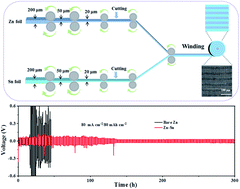A coaxial zinc–tin vertically oriented array-based anode for achieving ultrahigh areal current and capacity up to 80 mA cm−2 and 80 mA h cm−2†
Abstract
The anode-related challenges in aqueous zinc-ion batteries include zinc dendrites, hydrogen evolution reactions, passivation reactions, and structural instability. Unfortunately, most reported strategies have only partially solved the above challenges, resulting in the inability to achieve ultrahigh areal currents and capacities (e.g., >50 mA cm−2/50 mA h cm−2) and thus limiting their practical applications. According to the underlying principles of the developed strategies, combining unique chemical properties and a stable structure to suppress all the zinc anode challenges simultaneously is a promising approach to obtain new types of zinc anodes with ultrahigh areal current and capacity. Here, a coaxial zinc–tin (Zn–Sn) vertically oriented array-based anode has been constructed. The structural characterizations confirm that the obtained anode had unique vertically oriented Zn and Sn foil arrays, as well as a coaxial framework. Remarkably, the Zn–Sn vertically oriented array-based symmetrical cells could work at 80 mA cm−2/80 mA h cm−2 for 300 h (150 cycles), far outperforming all the previously reported zinc anodes in aqueous electrolytes. Analysis shows that Sn could homogenize the ion flux distribution and the electric field, enhance electron transfer, and regulate zinc nucleation/growth. Furthermore, the Sn foil could be used as a valid anchor to stabilize the zinc anode, as well as form the 3D electron diffusion structure. Moreover, the corresponding full cells delivered high discharge capacity (240 mA h g−1), superior rate performance (20 A g−1, 121 mA h g−1), and long cycle stability. This vertically oriented array-based strategy can be used to develop other types of metal anodes to achieve high areal current and capacity.



 Please wait while we load your content...
Please wait while we load your content...